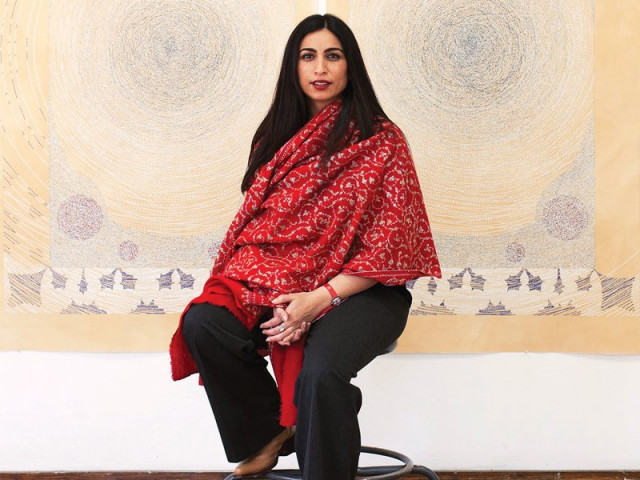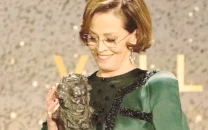A portrait of the artist, Ambreen Butt
Ambreen’s work speaks volumes about modern Pakistani art.

“Out beyond ideas of wrongdoing and rightdoing, there is a field. I’ll meet you there” — Rumi. PHOTO: TONY LUONG
Another wall is covered with what look like little resin toes and fingers. “I was on the phone with a friend of mine who was visiting Lahore, and she narrowly escaped a bomb in a bazaar,” Ambreen explains, “I remember thinking how we can never picture our own death. Yet it is so real at the same time. We rely heavily on the news, but can never step outside and see ourselves. We can never even imagine it and we take it for granted.” The crimson digits are cast on the wall in delicate layers, like rose petals coming as a whole and exploding like fireworks. “You never really pay attention to your fingers,” she says. “They’re little bits of skin, muscles, bones and nail. I wanted to make the viewer look at themselves differently and to bring attention to the precariousness of life. It’s a very ugly reality”.


Ambreen’s work, displayed in galleries all over the United States, speaks volumes about modern Pakistani art. Her latest work was showcased in the Carroll and Sons gallery in South Boston and was moved to the Tufts’ Tisch Gallery in January this year.
Ambreen began painting professionally during her undergraduate years at the National College of Arts. She was fascinated by miniature painting and instantly picked it as her major. “The moment I saw it, I felt seduced by the art,” she says with a half-smile, “I was drawn in by everything”. “It is tangible, it’s so close to you and the marks are so small, they’re barely there,” she explains, “my relationship with my work took a lot out of me, but it was always worth it”.
While exploring the genre of miniature art, Ambreen realised that she wanted to do more than just carry the baton of a dying art form. “I wanted to contemporise it,” she says, “In the early 90s, contemporary miniature art from South Asia was alien to the western art world. It was almost a revival to make traditional techniques contemporary.”

For her undergraduate thesis on miniature painting, Ambreen combined her passion for social issues with stories from Khawateen magazines. “It was something out of teen auratein, teen kahaniyaan that compelled me to use the magazines,” Ambreen says, “the stories were all about breaking social boundaries, they were very real issues. You never really know if they were even true but they still had a deep impact on me”. She remembers one story which stuck with her. It was about a feudal family and a maid who grew up believing she was a part of the family until she was exploited.
“For me, art became about social issues when it came to miniature art,” Ambreen explains. “I was particularly struck by the representation of women in miniature art. They were often depicted as small seductive creatures. The male icons on the other hand resembled Krishna and had a more god-like representation,” she explains, “I was more concerned with the woman herself, rather than her body.”
After graduating, Ambreen applied to the Massachusetts College of Art and Design for a Masters in Fine Arts. The move to Boston proved to be a real boon for Ambreen. “Boston was a great place for reinventing myself as an artist and understanding my identity as a woman,” Ambreen explains. “I grew up very sheltered in Pakistan and I was used to being escorted everywhere. It was very different being on my own and having to confront my fears.”

During her early years in Massachusetts, Ambreen rented a room from Boston University Anthropology Professor, Shahla Haeri, and her husband Walter Crump. They had met in Pakistan when Ambreen was a student at NCA where Crump was teaching photography. “Ambreen’s work has gone through numerous changes and transitions,” Haeri says, “some of her abstract pieces have a number of intricate layers and I find that really exciting as it has a transcendental value that can stand the test of time, especially since feminist consciousness is becoming very important.”
“Ambreen’s narrative feminist pieces are easier to understand and interpret in the framework of their time,” says Haeri, “I particularly like one of her works where a woman is standing on a fish. It’s a beautiful image.”
For Ambreen, exploring her art forms led her to create her own style of work. “I never do things on other people’s terms, I never did. I had always known what I wanted. If I try to force myself to do something else, it never really works for me, and it’s a disaster for everyone else,” she laughs. “I’m rebellious in my own way, I want my message to be delivered in the right vocabulary,” she says, “You have to create your own vocabulary, according to the space and time you’re living in.”
For Ambreen, her work represents her understanding of the world out there. “As an artist, it’s difficult to make a wall between your life and your work,” she says. She is also very particular about the materials she uses. Inspired by Wasli, the handmade paper traditionally used for miniature painting in South Asia, she decided to use transparent materials like plastic and layered them on top of each other. Some of her work also involves ripping pieces of paper. “It’s about transforming something new. The act of ripping has a sense of rejection, but you’re also not destroying, so in a way it’s a rebirth, and in that, it’s very personal,” she explains, “It’s about exploring the meaning of the written word, and a matter of interpretation.”

Her piece, Beyond the Ideas of Rightness or Wrongness features eleven drawings made from ripped pieces of Pakistan’s blasphemy law documents. The drawings depict the Punjab governor, Salmaan Taseer and his self-confessed assassin Mumtaz Qadri. Two portraits of the men hang on two different sides, but their features merge, as they blend into one another. “It was about interpretations, and how man-made texts can be elevated to the level of a holy scripture,” Ambreen says, “It is about heroic representation and that someone can be made out to be an angel or a demon. One can’t exist without the other and it’s about who you are seeing as a hero. Qadri was showered with rose petals, while Salmaan became a hero for giving up his life. It’s very reflective of your own person. It is a statement that extremism exists within you.
Published in The Express Tribune, Sunday Magazine, February 24th, 2013.
Like Express Tribune Magazine on Facebook to stay informed and join the conversation.

















COMMENTS
Comments are moderated and generally will be posted if they are on-topic and not abusive.
For more information, please see our Comments FAQ